For contemporary firms that cope with monumental volumes of paperwork resembling contracts, invoices, resumes, and reviews, effectively processing and retrieving pertinent information is important to sustaining a aggressive edge. Nevertheless, conventional strategies of storing and trying to find paperwork may be time-consuming and infrequently end in a big effort to discover a particular doc, particularly after they embrace handwriting. What if there was a option to course of paperwork intelligently and make them searchable in with excessive accuracy?
That is made doable with Amazon Textract, AWS’s Clever Doc Processing service, coupled with the quick search capabilities of OpenSearch. On this submit, we’ll take you on a journey to quickly construct and deploy a doc search indexing answer that helps your group to higher harness and extract insights from paperwork.
Whether or not you’re in Human Assets in search of particular clauses in worker contracts, or a monetary analyst sifting by a mountain of invoices to extract cost information, this answer is tailor-made to empower you to entry the data you want with unprecedented velocity and accuracy.
With the proposed answer, your paperwork are routinely ingested, their content material parsed and subsequently listed right into a extremely responsive and scalable OpenSearch index.
We’ll cowl how applied sciences resembling Amazon Textract, AWS Lambda, Amazon Simple Storage Service (Amazon S3), and Amazon OpenSearch Service may be built-in right into a workflow that seamlessly processes paperwork. Then we dive into indexing this information into OpenSearch and show the search capabilities that change into out there at your fingertips.
Whether or not your group is taking the primary steps into the digital transformation period or is a longtime large looking for to turbocharge data retrieval, this information is your compass to navigating the alternatives that AWS Clever Doc Processing and OpenSearch supply.
The implementation used on this submit makes use of the Amazon Textract IDP CDK constructs – AWS Cloud Growth Package (CDK) parts to outline infrastructure for Clever Doc Processing (IDP) workflows – which let you construct use case particular customizable IDP workflows. The IDP CDK constructs and samples are a set of parts to allow definition of IDP processes on AWS and revealed to GitHub. The principle ideas used are the AWS Cloud Development Kit (CDK) constructs, the precise CDK stacks and AWS Step Functions. The workshop Use machine learning to automate and process documents at scale is an efficient place to begin to study extra about customizing workflows and utilizing the opposite pattern workflows as a base on your personal.
Answer overview
On this answer, we give attention to indexing paperwork into an OpenSearch index for fast search-and-retrieval of data and paperwork. Paperwork in PDF, TIFF, JPEG or PNG format are put in an Amazon Easy Storage Service (Amazon S3) bucket and subsequently listed into OpenSearch utilizing this Step Capabilities workflow.

Determine 1: The Step Capabilities OpenSearch workflow
The OpenSearchWorkflow-Decider appears on the doc and verifies that the doc is among the supported mime varieties (PDF, TIFF, PNG or JPEG). It consists of 1 AWS Lambda operate.
The DocumentSplitter generates most of 2500-pages chunk from paperwork. This implies despite the fact that Amazon Textract helps paperwork of as much as 3000 pages, you possibly can cross in paperwork with many extra pages and the method nonetheless works superb and places the pages into OpenSearch and creates right web page numbers. The DocumentSplitter is carried out as an AWS Lambda operate.
The Map State processes every chunk in parallel.
The TextractAsync activity calls Amazon Textract utilizing the asynchronous Software Programming Interface (API) following best practices with Amazon Easy Notification Service (Amazon SNS) notifications and OutputConfig to retailer the Amazon Textract JSON output to a buyer Amazon S3 bucket. It consists of two Amazon Lambda capabilities: one to submit the doc for processing and one getting triggered on the Amazon SNS notification.
As a result of the TextractAsync activity can produce a number of paginated output information, the TextractAsyncToJSON2 course of combines them into one JSON file.
The Step Capabilities context is enriched with data that also needs to be searchable within the OpenSearch index within the SetMetaData step. The pattern implementation provides ORIGIN_FILE_NAME, START_PAGE_NUMBER, and ORIGIN_FILE_URI. You possibly can add any data to counterpoint the search expertise, like data from different backend programs, particular IDs or classification data.
The GenerateOpenSearchBatch takes the generated Amazon Textract output JSON, combines it with the data from the context set by SetMetaData and prepares a file that’s optimized for batch import into OpenSearch.
Within the OpenSearchPushInvoke, this batch import file is distributed into the OpenSearch index and out there for search. This AWS Lambda operate is linked with the aws-lambda-opensearch assemble from the AWS Solutions library utilizing the m6g.massive.search situations, OpenSearch model 2.7, and configured the Amazon Elastic Block Service (Amazon EBS) quantity dimension to Basic Goal 2 (GP2) with 200 GB. You possibly can change the OpenSearch configuration based on your necessities.
The ultimate TaskOpenSearchMapping step clears the context, which in any other case might exceed the Step Functions Quota of Most enter or output dimension for a activity, state, or execution.
Conditions
To deploy the samples, you want an AWS account , the AWS Cloud Development Kit (AWS CDK), a present Python model and Docker are required. You want permissions to deploy AWS CloudFormation templates, push to the Amazon Elastic Container Registry (Amazon ECR), create Amazon Identity and Access Management (AWS IAM) roles, Amazon Lambda capabilities, Amazon S3 buckets, Amazon Step Capabilities, Amazon OpenSearch cluster, and an Amazon Cognito person pool. Make sure that your AWS CLI environment is setup with the in accordance permissions.
It’s also possible to spin up a AWS Cloud9 occasion with AWS CDK, Python and Docker pre-installed to provoke the deployment.
Walkthrough
Deployment
- After you arrange the conditions, you should first clone the repository:
- Then cd into the repository folder and set up the dependencies:
- Deploy the OpenSearchWorkflow stack:
The deployment takes round 25 minutes with the default configuration settings from the GitHub samples, and creates a Step Capabilities workflow, which is invoked when a doc is put at an Amazon S3 bucket/prefix and subsequently is processed until the content material of the doc is listed in an OpenSearch cluster.
The next is a pattern output together with helpful hyperlinks and data generated fromcdk deploy OpenSearchWorkflowcommand:
This data can be out there within the AWS CloudFormation Console.
When a brand new doc is positioned below the OpenSearchWorkflow.DocumentUploadLocation, a brand new Step Capabilities workflow is began for this doc.
To examine the standing of this doc, the OpenSearchWorkflow.StepFunctionFlowLink offers a hyperlink to the listing of StepFunction executions within the AWS Administration Console, displaying the standing of the doc processing for every doc uploaded to Amazon S3. The tutorial Viewing and debugging executions on the Step Functions console offers an summary of the parts and views within the AWS Console.
Testing
- First take a look at utilizing a pattern file.
- After deciding on the hyperlink to the StepFunction workflow or open the AWS Administration Console and going to the Step Capabilities service web page, you possibly can take a look at the totally different workflow invocations.

Determine 2: The Step Capabilities executions listing
- Check out the presently working pattern doc execution, the place you possibly can observe the execution of the person workflow duties.
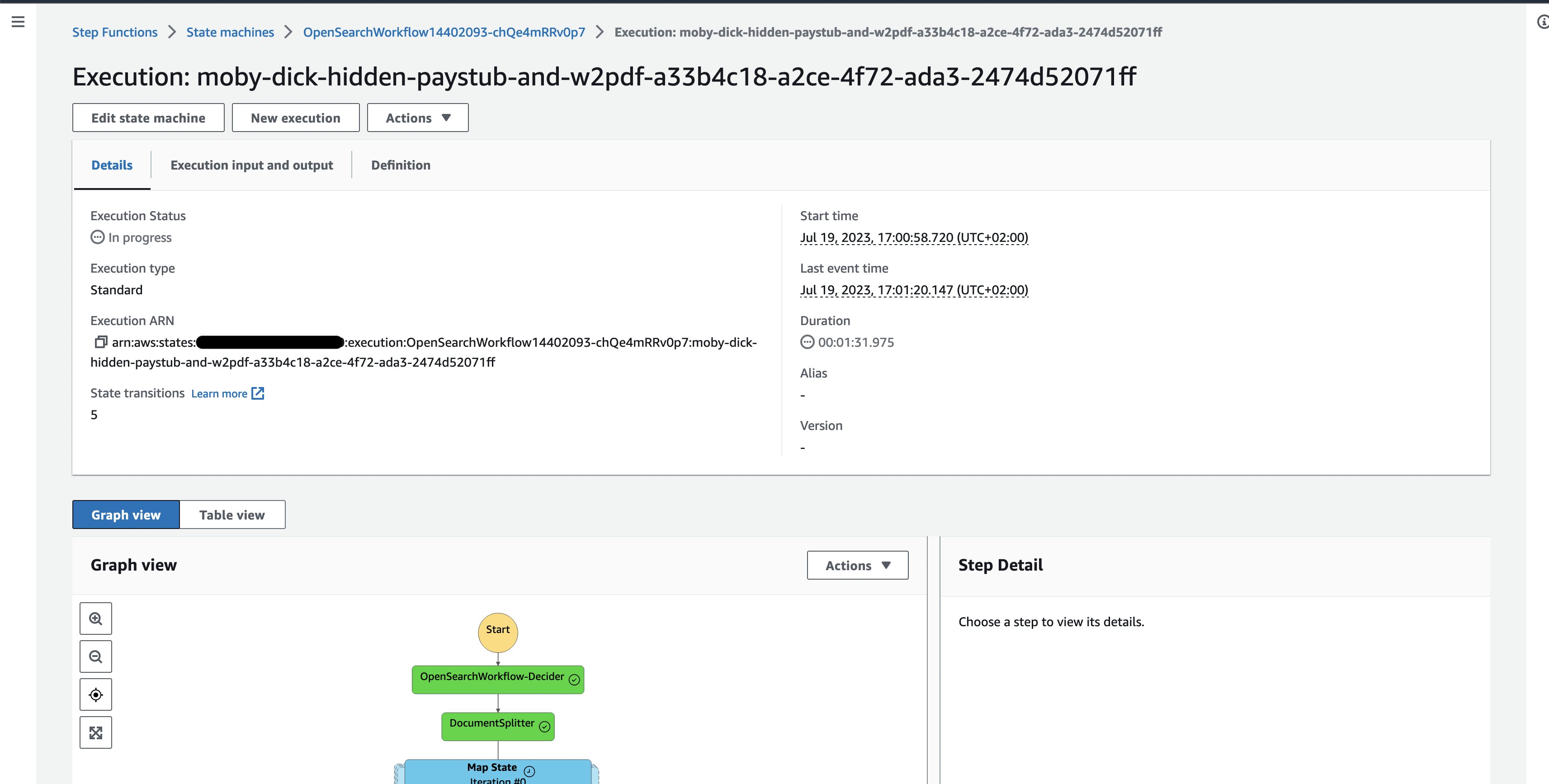
Determine 3: One doc Step Capabilities workflow execution
Search
As soon as the method completed, we will validate that the doc is listed within the OpenSearch index.
- To take action, first we create an Amazon Cognito person. Amazon Cognito is used for Authentication of customers towards the OpenSearch index. Choose the hyperlink within the output from the cdk deploy (or take a look at the AWS CloudFormation output within the AWS Administration Console) named OpenSearchWorkflow.CognitoUserPoolLink.
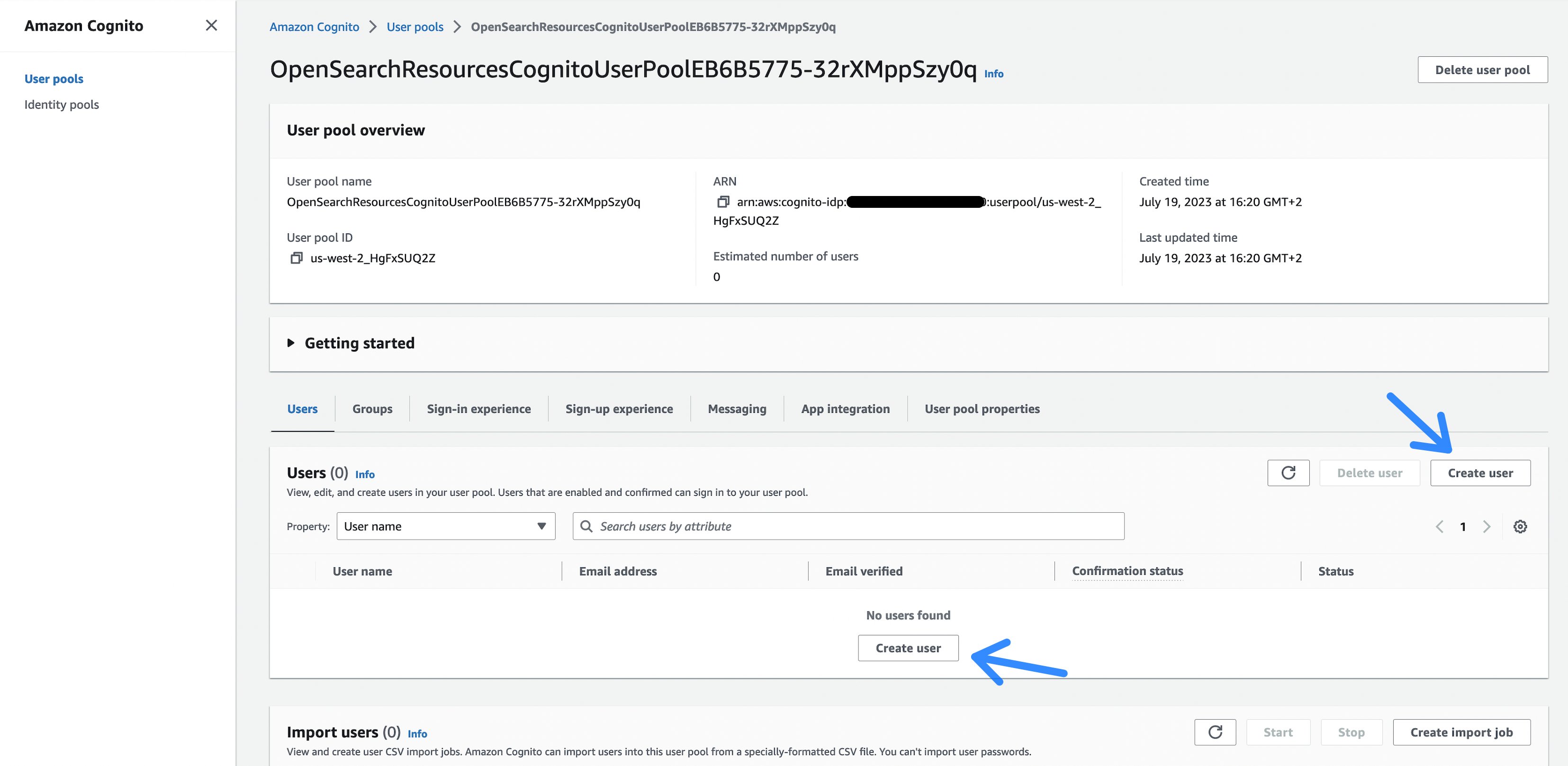
Determine 4: The Cognito person pool
- Subsequent, choose the Create person button, which directs you to a web page to enter a username and a password for accessing the OpenSearch Dashboard.
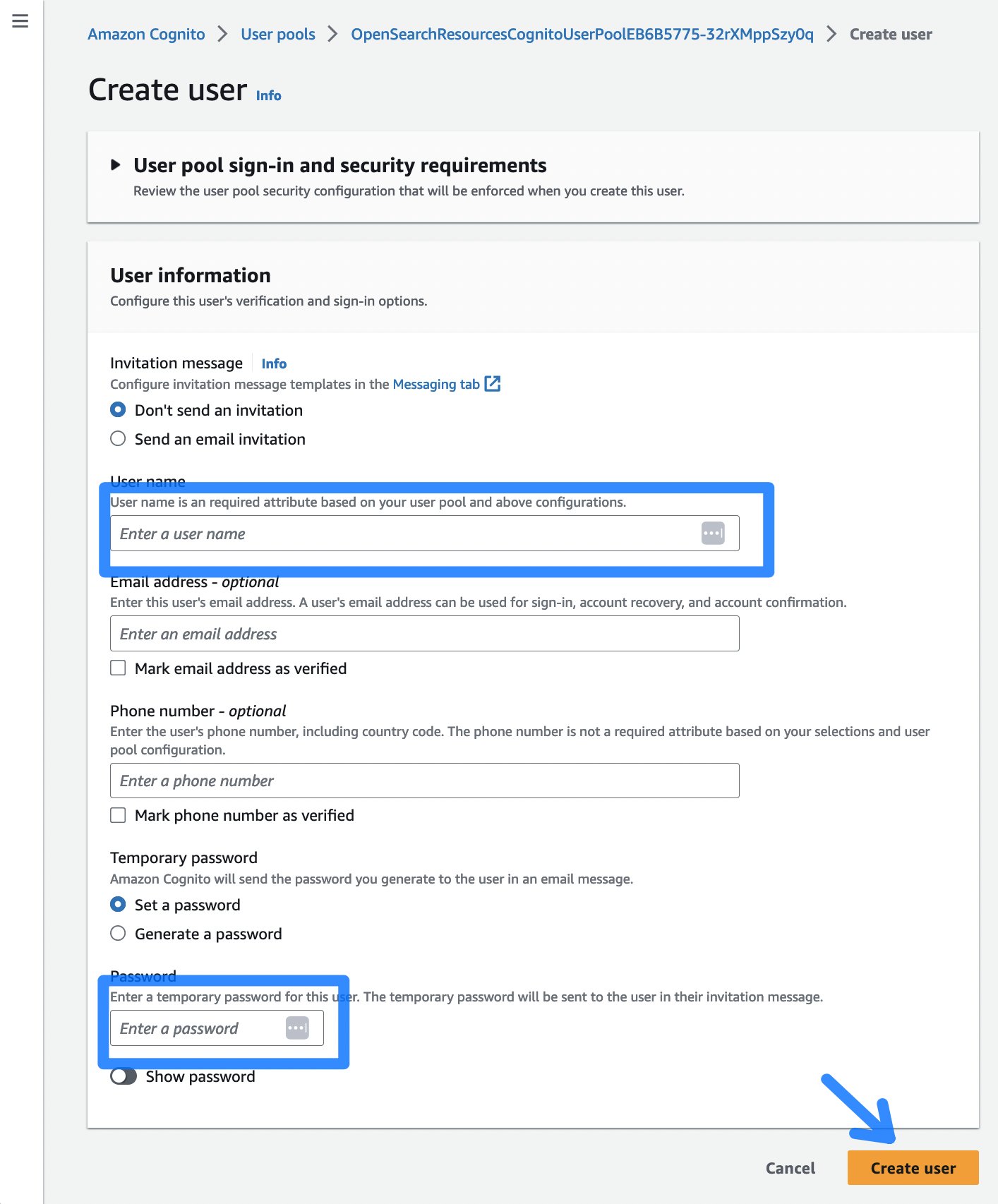
Determine 5: The Cognito create person dialog
- After selecting Create person, you possibly can proceed to the OpenSearch Dashboard by clicking on the OpenSearchWorkflow.OpenSearchDashboard from the CDK deployment output. Login utilizing the beforehand created username and password. The primary time you login, it’s important to change the password.
- As soon as being logged in to the OpenSearch Dashboard, choose the Stack Administration part, adopted by Index Samples to create a search index.

Determine 6: OpenSearch Dashboards Stack Administration
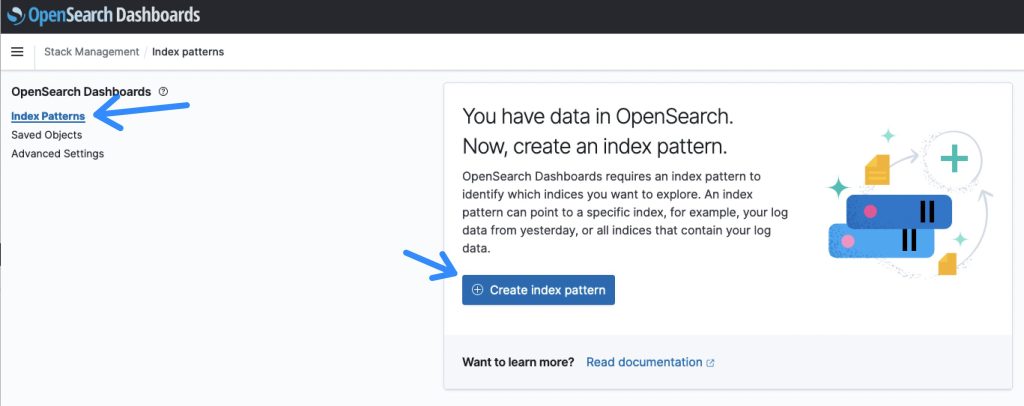
Determine 7: OpenSearch Index Patterns overview
- The default identify for the index is papers-index and an index sample identify of papers-index* will match that.
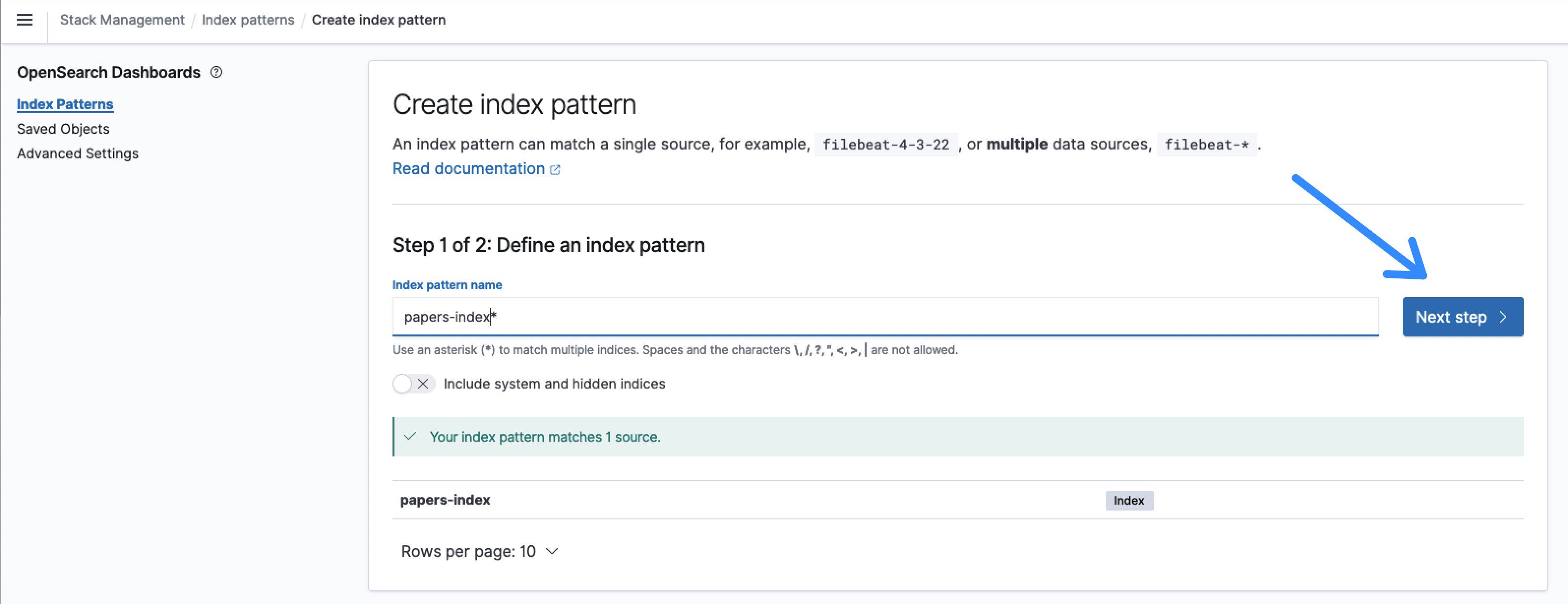
Determine 8: Outline the OpenSearch index sample
- After clicking Subsequent step, choose timestamp because the Time area and Create index sample.
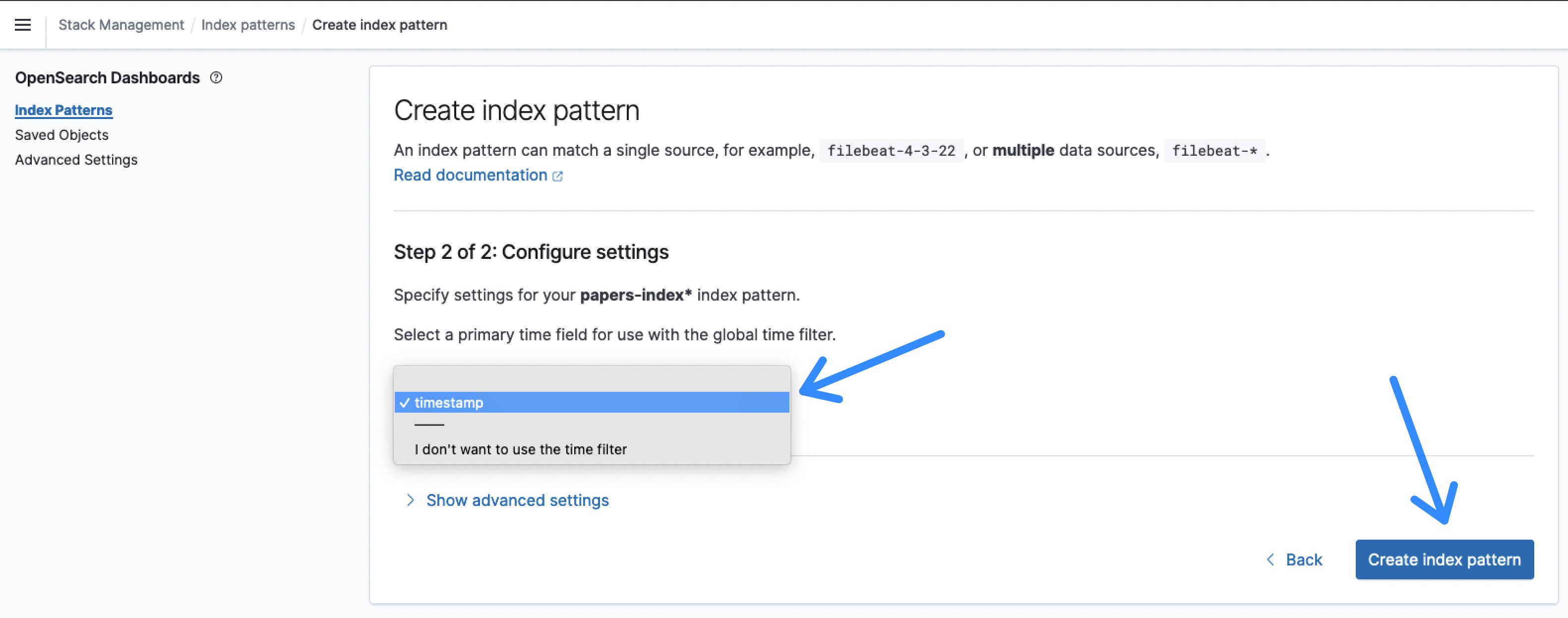
Determine 9: OpenSearch index sample time area
- Now, from the menu, choose Uncover.

Determine 10: OpenSearch Uncover
Normally ,you should change the time-span based on your final ingest. The default is quarter-hour and infrequently there was no exercise within the final quarter-hour. On this instance, it modified to fifteen days to visualise the ingest.
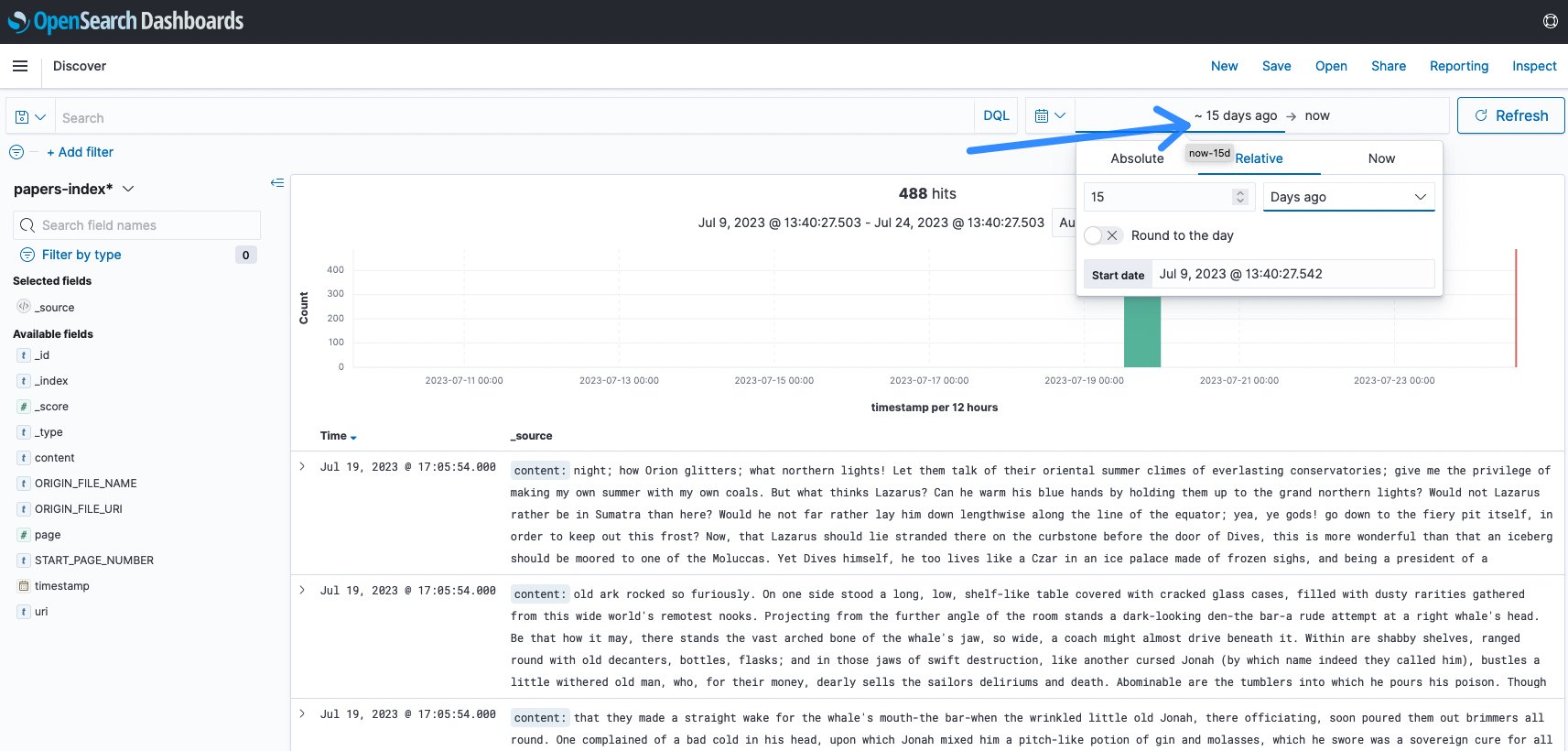
Determine 11: OpenSearch timespan change
- Now you can begin to look. A novel was listed, you possibly can seek for any phrases like name me Ishmael and see the outcomes.
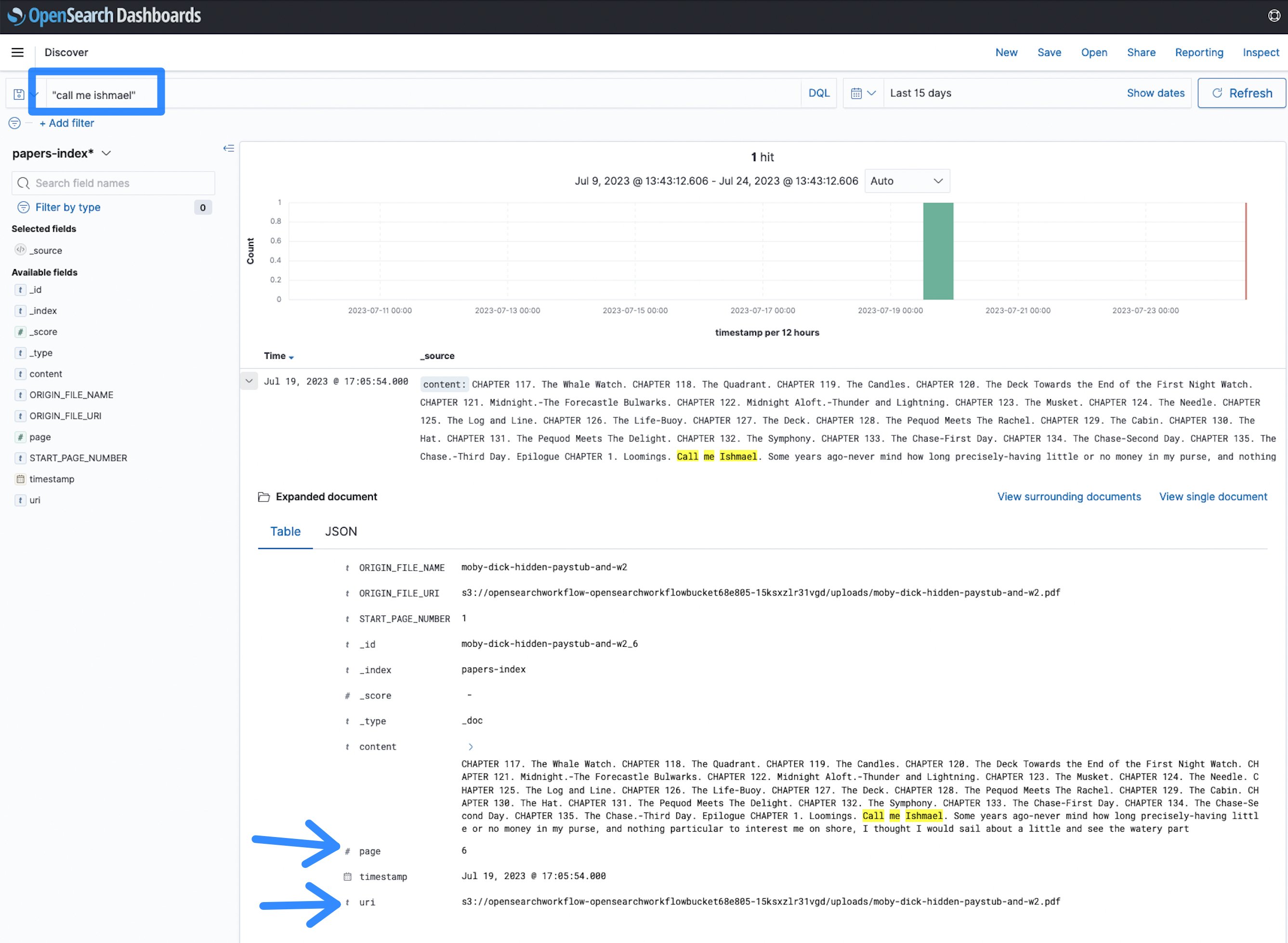
Determine 12: OpenSearch search time period
On this case, the time period name me Ishmael seems on web page 6 of the doc on the given Uniform Useful resource Identifier (URI), which factors to the Amazon S3 location of the file. This makes it quicker to determine paperwork and discover data throughout a big corpus of PDF, TIFF or picture paperwork, in comparison with manually skipping by them.
Operating at scale
With a purpose to estimate scale and period of an indexing course of, the implementation was examined with 93,997 paperwork and a complete sum of 1,583,197 pages (common 16.84 pages/doc and the biggest file having 3755 pages), which all received listed into OpenSearch. Processing all information and indexing them into OpenSearch took 5.5 hours within the US East (N. Virginia – us-east-1) area utilizing default Amazon Textract Service Quotas. The graph beneath reveals an preliminary take a look at at 18:00 adopted by the primary ingest at 21:00 and all achieved by 2:30.

Determine 13: OpenSearch indexing overview
For the processing, the tcdk.SFExecutionsStartThrottle was set to an executions_concurrency_threshold=550, which signifies that concurrent doc processing workflows are capped at 550 and extra requests are queued to an Amazon SQS Fist-In-First-Out (FIFO) queue, which is subsequently drained when present workflows end. The edge of 550 relies on the Textract Service quota of 600 within the us-east-1 area. Subsequently, the queue depth and age of oldest message are metrics price monitoring.
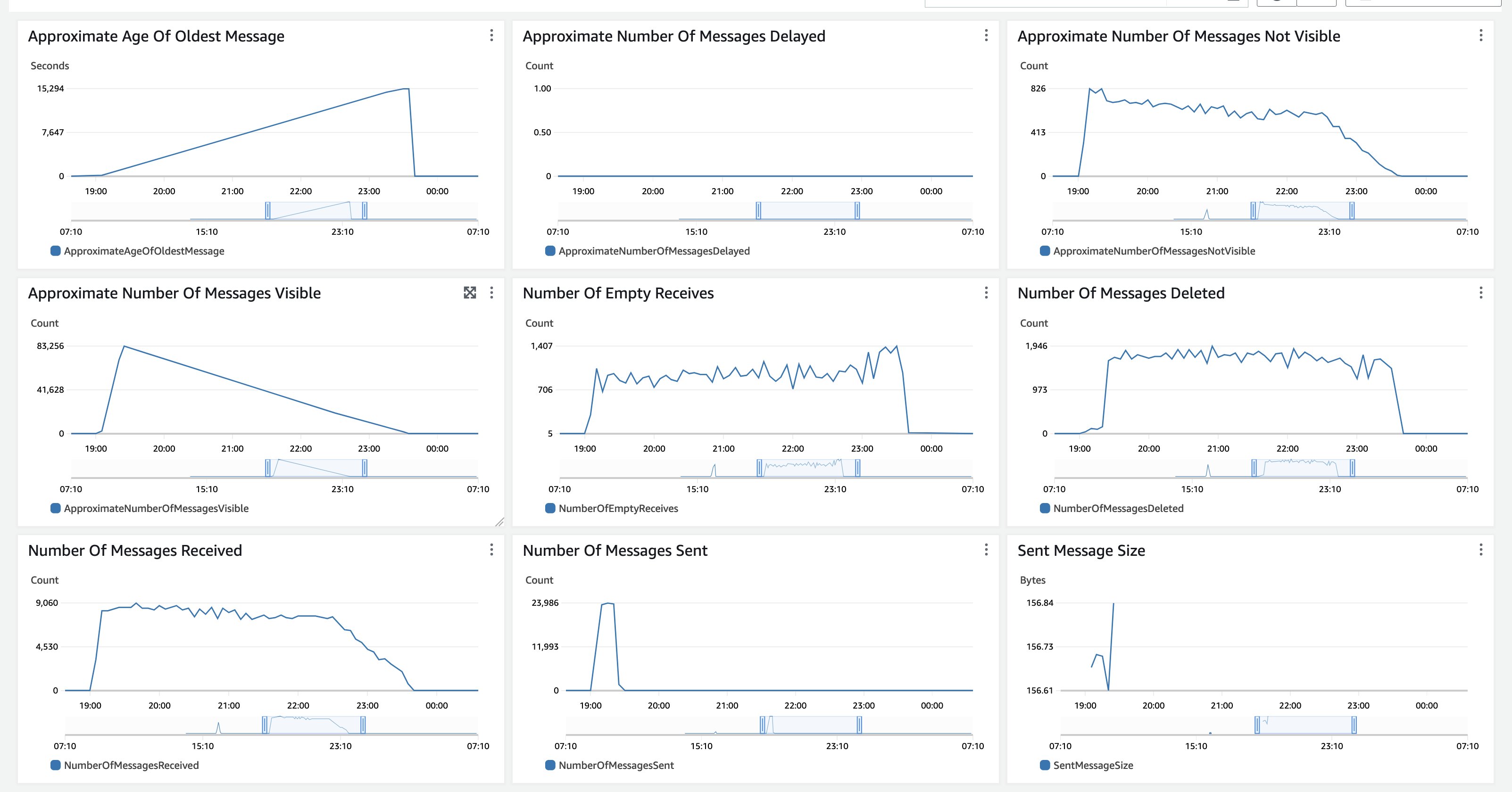
Determine 14: Amazon SQS monitoring
On this take a look at, all paperwork have been uploaded to Amazon S3 without delay, subsequently the Approximate Variety of Messages Seen has a steep enhance after which a gradual decline as no new paperwork are ingested. The Approximate Age Of Oldest Message will increase till all messages are processed. The Amazon SQS MessageRetentionPeriod is ready to 14 days. For very lengthy working backlog processing that might exceed 14 days processing, begin with processing a smaller subset of consultant paperwork and monitor the period of execution to estimate what number of paperwork you possibly can cross in earlier than exceeding 14 days. The Amazon SQS CloudWatch metrics look comparable for a use case of processing a big backlog of paperwork, which is ingested without delay then processed absolutely. In case your use case is a gradual movement of paperwork, each metrics, the Approximate Variety of Messages Seen and the Approximate Age Of Oldest Message will likely be extra linear. It’s also possible to use the brink parameter to combine a gradual load with backlog processing and allocate capability based on your processing wants.
One other metrics to watch is the well being of the OpenSearch cluster, which you need to setup based on the Opernational best practices for Amazon OpenSearch Service. The default deployment makes use of m6g.massive.search situations.

Determine 15: OpenSearch monitoring
Here’s a snapshot of the Key Efficiency Indicators (KPI) for the OpenSearch cluster. No errors, fixed indexing information charge and latency.
The Step Capabilities workflow executions present the state of processing for every particular person doc. If you happen to see executions in Failed state, then choose the main points. A superb metric to watch is the AWS CloudWatch Automatic Dashboard for Step Capabilities, which exposes among the Step Functions CloudWatch metrics.

Determine 16: Step Capabilities monitoring executions succeeded
On this AWS CloudWatch Dashboard graph, you see the profitable Step Capabilities executions over time.

Determine 17: OpenSearch monitoring executions failed
And this one reveals the failed executions. These are price investigating by the AWS Console Step Capabilities overview.
The next screenshot reveals one instance of a failed execution as a result of origin file being of 0 dimension, which is sensible as a result of the file has no content material and couldn’t be processed. You will need to filter failed processes and visualizes failures, so as so that you can return to the supply doc and validate the basis trigger.
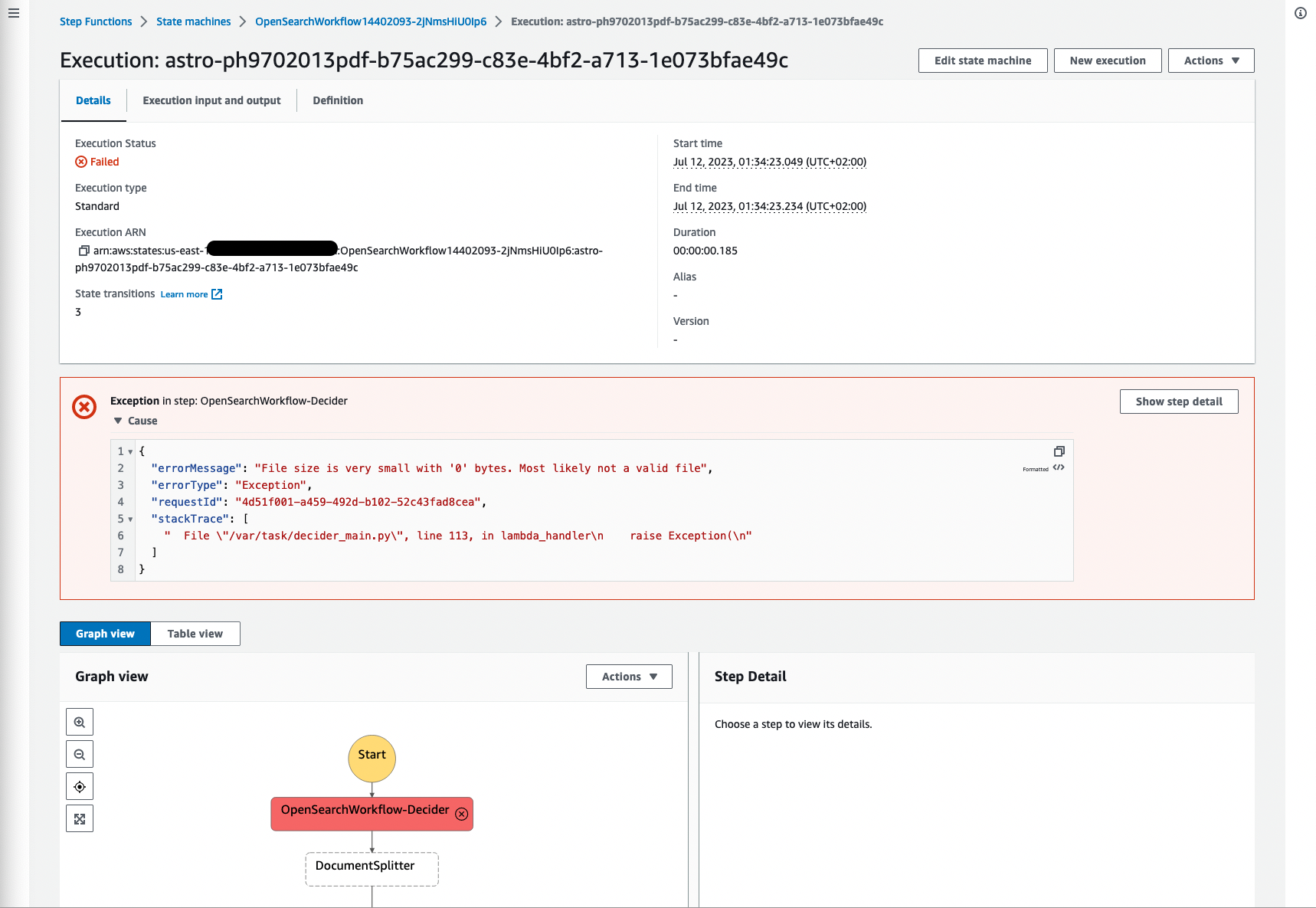
Determine 18: Step Capabilities failed workflow
Different failures would possibly embrace paperwork that aren’t of mime sort: utility/pdf, picture/png, picture/jpeg, or picture/tiff as a result of different doc varieties are usually not supported by Amazon Textract.
Price
The full value of ingesting 1,583,278 pages was cut up throughout AWS providers used for the implementation. The next listing serves as approximate numbers, as a result of your precise value and processing period differ relying on the dimensions of paperwork, the variety of pages per doc, the density of data within the paperwork, and the AWS Area. Amazon DynamoDB was consuming $0.55, Amazon S3 $3.33, OpenSearch Service $14.71, Step Capabilities $17.92, AWS Lambda $28.95, and Amazon Textract $1,849.97. Additionally, understand that the deployed Amazon OpenSearch Service cluster is billed by the hour and can accumulate increased value when run over a time frame.
Modifications
Most certainly, you need to modify the implementation and customise on your use case and paperwork. The workshop Use machine learning to automate and process documents at scale presents a great overview on the way to manipulate the precise workflows, altering the movement, and including new parts. So as to add customized fields to the OpenSearch index, take a look at the SetMetaData activity within the workflow utilizing the set-manifest-meta-data-opensearch AWS Lambda operate so as to add meta-data to the context, which will likely be added as a area to the OpenSearch index. Any meta-data data will change into a part of the index.
Cleansing up
Delete the instance sources in the event you not want them, to keep away from incurring future prices utilizing the followind command:
in the identical setting because the cdk deploy command. Beware that this removes the whole lot, together with the OpenSearch cluster and all paperwork and the Amazon S3 bucket. If you wish to preserve that data, backup your Amazon S3 bucket and create an index snapshot from your OpenSearch cluster. If you happen to processed many information, then you might have to empty the Amazon S3 bucket first utilizing the AWS Administration Console (i.e., after you took a backup or synced them to a special bucket if you wish to retain the data), as a result of the cleanup operate can day trip after which destroy the AWS CloudFormation stack.
Conclusion
On this submit, we confirmed you the way to deploy a full stack answer to ingest numerous paperwork into an OpenSearch index, that are prepared for use for search use instances. The person parts of the implementation have been mentioned in addition to scaling issues, value, and modification choices. All code is accessible as OpenSource on GitHub as IDP CDK samples and as IDP CDK constructs to construct your individual options from scratch. As a subsequent step you can begin to switch the workflow, add data to the paperwork within the search index and discover the IDP workshop. Please remark beneath in your expertise and concepts to develop the present answer.
In regards to the Writer
 Martin Schade is a Senior ML Product SA with the Amazon Textract workforce. He has over 20 years of expertise with internet-related applied sciences, engineering, and architecting options. He joined AWS in 2014, first guiding among the largest AWS prospects on probably the most environment friendly and scalable use of AWS providers, and later targeted on AI/ML with a give attention to pc imaginative and prescient. Presently, he’s obsessive about extracting data from paperwork.
Martin Schade is a Senior ML Product SA with the Amazon Textract workforce. He has over 20 years of expertise with internet-related applied sciences, engineering, and architecting options. He joined AWS in 2014, first guiding among the largest AWS prospects on probably the most environment friendly and scalable use of AWS providers, and later targeted on AI/ML with a give attention to pc imaginative and prescient. Presently, he’s obsessive about extracting data from paperwork.


